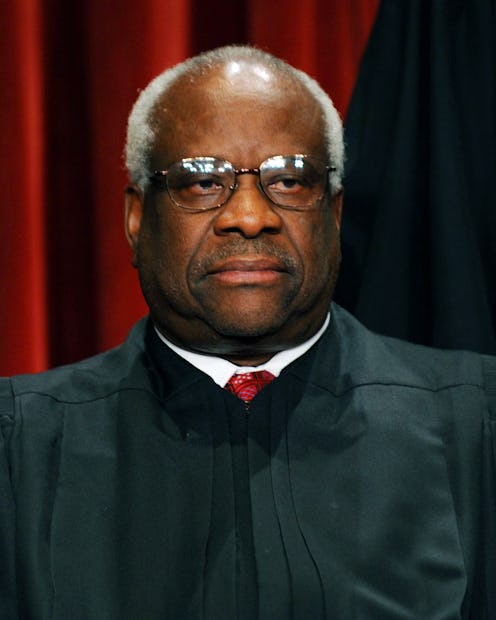News
Read Justice Thomas' Absurd Abortion Dissent
After the historic ruling in Whole Woman's Health v. Hellerstedt, which was a major win for women across the country, Justice Clarence Thomas' abortion dissent was a slap in the face to women, his fellow justices who voted in favor of the case, and pro-choice individuals everywhere.
In the 5-3 vote, Justices Samuel Alito, John Roberts, and Thomas were the three members of the Supreme Court who were convinced that Texas' House Bill 2 (HB2) did not cause any undue burden on women. In fact, by ruling against Whole Woman's Health, these justices made it clear that ensuring women can access safe and legal abortions is not a priority to them. Although Justice Thomas is notorious for not asking questions during oral arguments, he voiced his opinion loud and clear when he ruled against Whole Woman's Health in the June 26 hearing.
In his dissent after the case, Thomas wrote about the Supreme Court's decision to strike down two requirements previously passed under HB2: "That decision exemplifies the court's troubling tendency 'to bend the rules when any effort to limit abortion, or even to speak in opposition to abortion, is at issue.'" Interestingly, Thomas was quoting the late Justice Antonin Scalia who wrote something similar in a previous dissent for a previous abortion case.
Justice Thomas went on to argue that the majority of the Supreme Court, the highest court in the land, mind you, simply voted according to the wishes of abortion clinics and providers. "As the Court applies whatever standard it likes to any given case, nothing but empty words separates our constitutional decisions from judicial fiat," Thomas wrote in a scathing review of his fellow justices who ruled in favor of Whole Woman's Health.
Thomas was clearly unhappy with the court's decision, and he explicitly brought up the idea behind the "undue burden" placed on women (or not placed on women, according to Thomas) under HB2:
But the problem now goes beyond that. If our recent cases illustrate anything, it is how easily the Court tinkers with levels of scrutiny to achieve its desired result. This Term, it is easier for a State to survive strict scrutiny despite discriminating on the basis of race in college admissions than it is for the same State to regulate how abortion doctors and clinics operate under the putatively less stringent undue-burden test.
And it only gets worse from there. The "undue burden" that HB2 imposed on women seemed pretty clear to me; by requiring abortion providers to have admitting privileges at a nearby hospital and to require abortion clinics follow the same architectural dimensions as ambulatory service centers severely diminishes the number of available clinics in any given area. By reducing the number of abortion clinics, especially in a massive state like Texas that has an approximate 5.4 million women of reproductive age, the "undue burden" is that women who are seeking a safe and legal abortion are likely unable to access the few remaining abortion clinics in their area.
One example is that the number of abortion clinics in Texas have decreased from 42 in 2013 to just 19 clinics this year. Moreover, the majority of those clinics are in the four major metropolitan areas, meaning women living outside of those areas will have to travel far distances just to get a consultation for an abortion.
Despite this evidence, Thomas' dissent proved that he's not exactly sure how this whole "undue burden" thing works:
Today’s opinion does resemble Casey in one respect: After disregarding significant aspects of the Court’s prior jurisprudence, the majority applies the undue-burden standard in a way that will surely mystify lower courts for years to come.
Later in his dissent, Thomas basically said that the Supreme Court just makes things up to get what it wants:
The illegitimacy of using ‘made-up tests’ to ‘displace longstanding national traditions as the primary determinant of what the Constitution means’ has long been apparent. . . The Constitution does not prescribe tiers of scrutiny. The three basic tiers— ‘rational basis,’ intermediate, and strict scrutiny—’are no more scientific than their names suggest, and a further element of randomness is added by the fact that it is largely up to us which test will be applied in each case.’. . . But the problem now goes beyond that. If our recent cases illustrate anything, it is how easily the Court tinkers with levels of scrutiny to achieve its desired result.
As if Justice Thomas' entire dissent wasn't bad enough for those in support of Whole Woman's Health, he ended on a real kicker, essentially arguing that although some may think this was a victorious ruling, it was a colossal loss to the nation and the law:
Today’s decision will prompt some to claim victory, just as it will stiffen opponents’ will to object. But the entire Nation has lost something essential. The majority’s embrace of a jurisprudence of rights-specific exceptions and balancing tests is ‘a regrettable concession of defeat—an acknowledgement that we have passed the point where ‘law,’ properly speaking, has any further application.’
You can't make everyone happy in life, especially with controversial case hearings in the Supreme Court. But despite Thomas' scathing dissent that tried to renounce the absolutely historic moment for women all across the country, I'd say we still came out on top.
